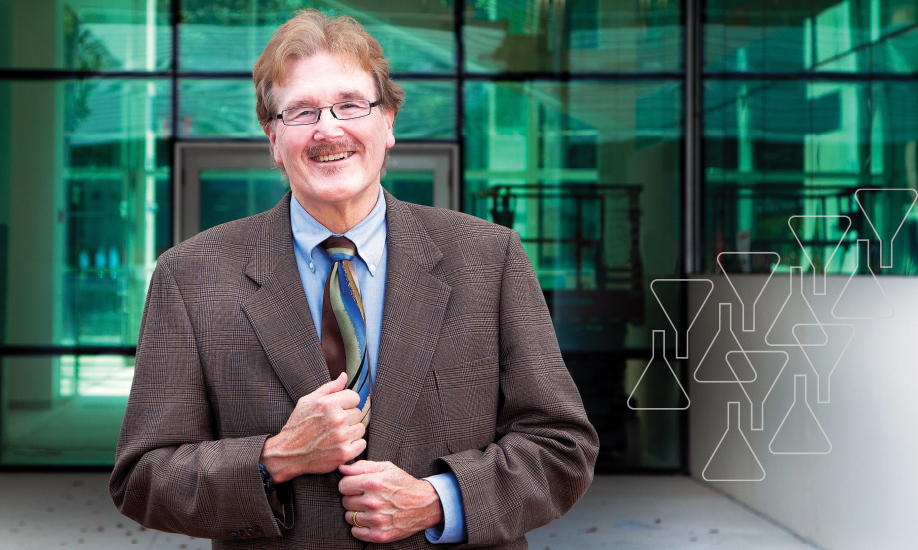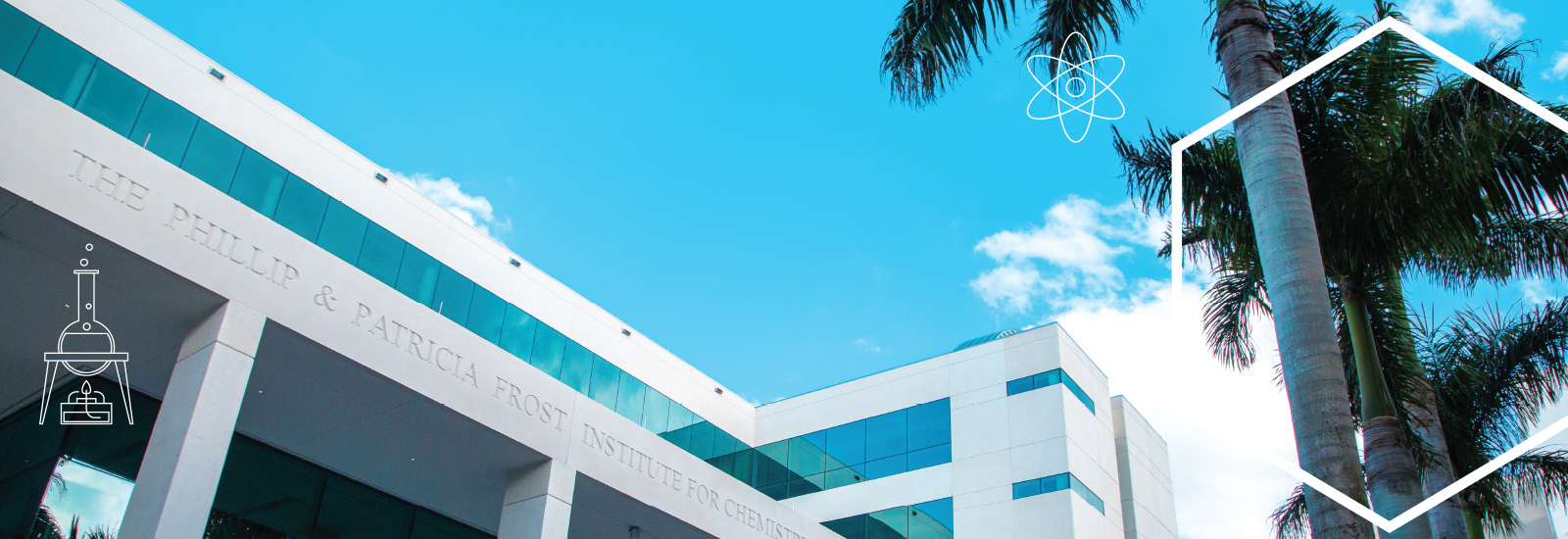by JANETTE NEUWAHL TANNEN
FACULTY MEMBERS ARE MOVING THEIR LABS INTO THE NEW PHILLIP AND PATRICIA FROST INSTITUTE FOR CHEMISTRY AND MOLECULAR SCIENCE, ONE OF THE NEWEST BUILDINGS ON THE CORAL GABLES CAMPUS AND WIDELY CONSIDERED A FOCAL POINT FOR NEW RESEARCH AND DISCOVERY.
Supported by a generous donation from benefactors Phillip and Patricia Frost, the columned six-story edifice is located at the end of Memorial Drive, between the McArthur Engineering Building and the Ashe Administration Building. It is the first of a series of Frost Institutes that will focus on the intersection of science, technology, engineering, and mathematics—a key initiative of the University’s strategic Roadmap to Our New Century set in motion through a $100 million donation from the Frosts in 2017.
“This Frost Institute will enable the University of Miami to elevate our research capabilities and delve into projects at the forefront of the chemistry, molecular science, environmental and biomedical fields, and ultimately, to translate ideas into important global solutions,” says Jeffrey Duerk, executive vice president for academic affairs and provost. “Since chemistry and molecular science are critical to the foundation for so many other fields, we hope that faculty and students across the U will take advantage of this incredible resource.”
The highly specialized, 94,000-square-foot facility will focus on research at the molecular level, often invisible to the human eye without microscopes. But by examining cells and particles at such tiny scales, researchers can learn more about their structure and experiment with treatments for diseases and illnesses. This is a crucial step in the development of novel medical treatments and therapeutics, says Dr. Mark Yeager, the institute’s executive director.
The building’s labs will also enable scientists to examine metals and alloys at the molecular level to develop, for example, new computer chips, or batteries for electric cars, Yeager notes.
“Students really want to make their work relevant and have it impact the human condition, and I feel the same way,” says Yeager, who is also a cardiologist and professor of chemistry, biochemistry, and molecular biology. “I love science, but it manifests so much more meaning if you see how it can help people improve their lives.”
Before coming to the U, Yeager led the University of Virginia School of Medicine’s Department of Molecular Physiology and Biological Physics for 11 years and helped establish the Sheridan G. Snyder Translational Research Building. Throughout his career, Yeager learned the power of collaboration, and he says the Frost Institute will spur more research across disciplines.
“People often refer to the problem of silos, where traditional departments like chemistry, physics, and medicine are insular, when in fact there could be a lot of synergism,” Yeager says. “The idea of the Frost Institute is that it will become a driver of this synergy and provide the opportunity to align scientists and clinicians pursuing the same areas to work together. It will integrate all the expertise to solve unmet clinical needs and environmental problems.”
Science on Display
Yeager does not want to attract just faculty members, though. The entire building is designed to engage the University and larger community in its research. With floor-to-ceiling windows and a massive screen hanging in the lobby, passersby will be able to see video feeds of ongoing research inside the shared Molecular Electron Microscopy Center. The state-of-the-art lab will eventually have five specialized, leading-edge microscopes enabling visualization from atoms to cells, that anyone in the University can utilize.
“It was part of the design to put it at the crossroads of student traffic on campus,” says Leonidas Bachas, dean of the College of Arts and Sciences and a biological and analytical chemist who served as the institute’s interim director. “You can’t miss it, and I hope students will also get excited about what’s happening inside.”
Pratim Biswas, dean of the College of Engineering and a professor of chemical, environmental, and materials engineering, says many of his collaborators are already interested in visiting the facility.
“There’s nothing south of the Oak Ridge National Laboratory in Tennessee that has this type of equipment for molecular science,” says Biswas, who is moving his aerosol and air quality lab to the third floor. “It is a state-of-the-art facility built to do some unique research. And it will become the pride of the University so that researchers will come to us.”
All the laboratories also have an open design to encourage communication and cooperation. And throughout each floor, there are communal conference rooms and huddle rooms, where students and researchers can discuss experiments, says Jessica Brumley, vice president of facilities operations and planning at the University.
“This is a new way of building research facilities so that the flow of ideas is not impeded and researchers can move easily from one bench to another,” Bachas adds.
Innovative Occupants
While the first three floors are ready for occupants, Yeager is actively looking to hire additional faculty members. He will hire more as the fourth and fifth floors are completed in early 2024.
The first floor features a grand 24-foot ceiling that reaches the top of the second floor, an open seminar room with a display lab, and a large great hall. In the shared Molecular Electron Microscopy Center, researchers will be able to examine the atomic structure of hard materials such as metal alloys. Several of the instruments also will be able to apply the technique of cryoEM, where sensitive biological samples, like proteins and molecular complexes, are flash-frozen and studied. These images provide deeper insight into human physiology, which is critical for drug discovery.
The second floor will house Yeager’s lab and other scientists working on molecular drug design. For most of Yeager’s research, he uses cryoEM. This method inspired his previous research on gap junction channels. These channels stimulate cooperation and signaling between the body’s cells. They are particularly important in the heart, where these channels help maintain a normal heartbeat. By analyzing them, Yeager was able to reveal some of the cellular changes that occur during a heart attack, but he has also used cryoEM to study how HIV-1—the virus that causes AIDS—can enter host cells, replicate, and assemble infectious particles.
The third floor will be devoted to aerosol sciences, which examine the formation, transportation, and synthesis of particles from their molecular constituents. Today, the field is considered part of nanotechnology, a new branch of chemistry where scientists manipulate individual atoms and molecules to create new medical therapeutics and novel materials, as well as innovative energy and environmental technologies.
Now, after more than two years of construction, University leaders are eager to see the Frost Institute become a hive of innovation.
“Our hope is that 10 years from now we’ll be looking back and saying this major drug was discovered here because we had the right people, technology, and the right collaborative attitude,” Bachas says. “Hopefully, the Frost Institute will become a catalyst for major discoveries that happen on our campus and that can somehow be helpful to the world.”

This is a crucial step in the development of novel medical treatments and therapeutics.





